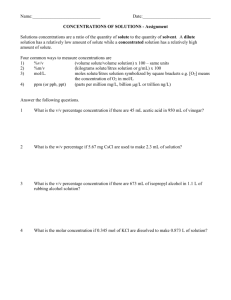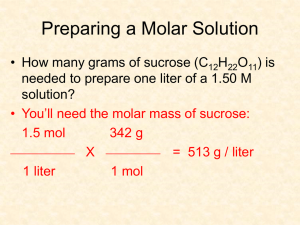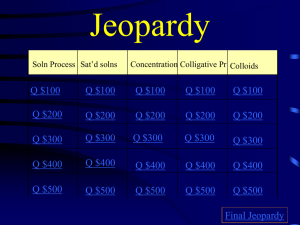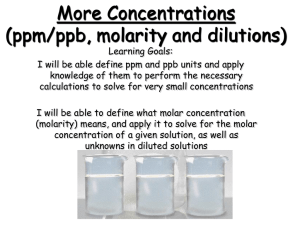File
advertisement
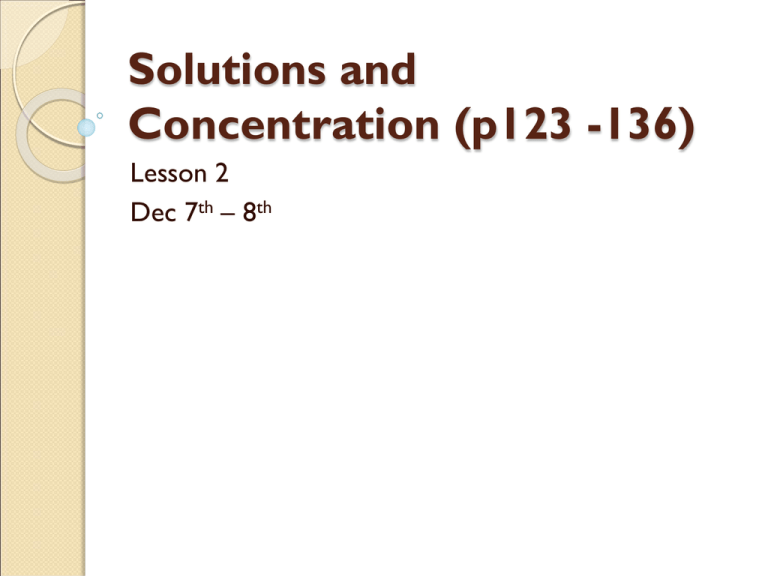
Solutions and Concentration (p123 -136) Lesson 2 Dec 7th – 8th Homework from Monday P 276 figure 6- predict solubility, p 269 # 8, p 271 # 4, 5, 6, p 277 # 4,5, p 279 # 9-12, p280 # 2-4 Concentration of solutions The concentration of a solution is the ratio of the quantity of solute to the quantity of solution. Whenever possible, reactions are carried out with all of the reactants in the same fluid phase. Liquids with liquids and gases with gases. Types of solutions Dilute solution - ratio of solute to solvent is very small. ◦ Example - a few crystals of sugar in a glass of water. Concentrated solution the ratio of solute to solvent is large. ◦ Example - Maple syrup is a concentrated solution of sugar in water. Saturated solution - no more solute can be dissolved in the solvent at a particular temperature. Unsaturated solution - the ratio of solute to solvent is lower than that of the corresponding saturated solution. If more solute is added to an unsaturated solution, at least some of it should dissolve Supersaturated solution is an unstable system in which the ratio of dissolved solute to solvent is higher than that of a saturated solution. A supersaturated solution can be made by gently cooling a hot saturated solution. At a lower temperature the dissolved solute can be made to precipitate out when a seed crystal is added. The process is called precipitation and the substance that forms is the precipitate. Supersaturated solution The amount of solute needed to make a saturated solution in a given quantity of solvent at a specific temperature is called the solubility of the solution. Concentrations There are 3 basic ways to express concentration 1. Percent concentration 2. Very low concentrations 3. Molar Concentrations Percent Concentration Can be expressed in V/V (volume by volume), W/W (weight by weight) or W/V (weight by volume) Volume by volume (V/V) concentration – 2 liquids Example 1 What is the % V/V if 30 mL of pure ethanol is added to 250 mL of water? vsolute = 30 mL vsolution = 250 mL + 30 mL = 280 mL csolution = ? csolution = vsolute x 100% vSolution csolution = 30 mL X 100% 280 mL csolution = 10.7 % V/V Therefore, 30 ml of ethanol dissolved in 250 ml of water is a 10.7% solution. Weight by volume (W/V) concentration – liquid and solid Example 2 3 grams of H2O2 topical antibiotic solution is dissolved into 50mL of solution. What is the w/v concentration? mH2O2 = 3 g vsolution = 50 mL csolution = ? csolution = msolute x 100% vSolution csolution = 3 g x 100% 50 ml csolution = 6 % solution Therefore, the solution has a mass by volume concentration of 6%. Weight by weight (W/W) concentration – Example 3 What is the % W/W of copper in an alloy when 10 g of Cu is mixed with 250 g of Zn? mCu= 10 g = solute mZn = 250 g + solute = 260 g Concentration = ? c = msolute x 100% msolution Concetration = 10 g Cu x 100% 260 g csolution = 3.8 % solution Therefore the alloy has a percent concentration of 3.8 % copper. Page 284 # 2-8 VERY LOW CONCENTRATIONS Very low concentrations are expressed in parts per million Example 4 Dissolved O2 in water shows a concentration of 333 mL of water At SATP and 6.5 mg of O2. What is the concentration in ppm? mO2 = 6.5 mg look at chart above and see that ppm = 1mg/1L vH2O = 333mL = 0.333L cO2 = ? cO2 = m / v cO2 = 6.5mg / 0.333 L = 19.5 ppm Therefore, there are 19.5 parts of O2 for every million of water. Example 5 The maximum acceptable concentration of fluoride ions in municipal water supplies is 1.5 ppm. What is the maximum mass of fluoride ions you would get from a 0.250 L glass of water? cF = 1.5 mg/L look at chart above and see that ppm = 1mg/1L ratio = 1.5 mg / 1 L = concentration Therefore the maximum vH2O = 0.25 L amount of fluoride ions in 250 mF = ? ml of water is 0.375 mg. c = m / v rearrange to m=cxv questions Page 287 # 11-17 MOLAR CONCENTRATIONS AND MOLARITY Molar concentration or Molarity, is a way of specifying the amount of solute in one litre of solvent (mol /L). The abbreviated form is M or c. In some cases molar concentration is indicated by using square brackets. [NH3(aq)] = 0.5 mol/L Example 6 In a quantitative analysis, a stiochiometric calculation produced 0.15 mol of NaOH in a 0.250 mL solution. Calculate the molar concentration of sodium hydroxide. nNaOH = 0.15 mol v = 0.250 ml c =? c = n/v = 0.6 mol/L Therefore, the molar concentration of sodium hydroxide is 0.6 M. Example 7 A student requires 0.250 moles of NaCl for an experiment. The only thing available to them is a bottle with a solution labelled "0.400 M NaCl." What volume of the solution should be used? Give the answer in millilitres. n = 0.250 mol c = 0.400 mol/L = 0.400 mol / 1000 mL v=? v=n/c = 0.625 L Therefore, the student would need 625 ml of the 0.400mol /L solution. Example 8 How many grams of NaOH would be needed to produce 500 mL of solution with a molarity of 1 M. v = 500 mL = 0.5 L Now we must find the c = 1 mol/L mass n=? m=nxM n = 0.5 mol m = 20 g. Example 9 A student is heating water to cook pasta, they add 25 g of sodium chloride to 1.5 L of water. What is the molar concentration of the salt water? mNa = 25 g v = 1.5 L Molar concentration = ? M = 0.28 mol/L Therefore the molar concentration of the salt water is 0.28 mol/L Questions Page 290 # 19 – 22 Page 290 # 2 - 8
